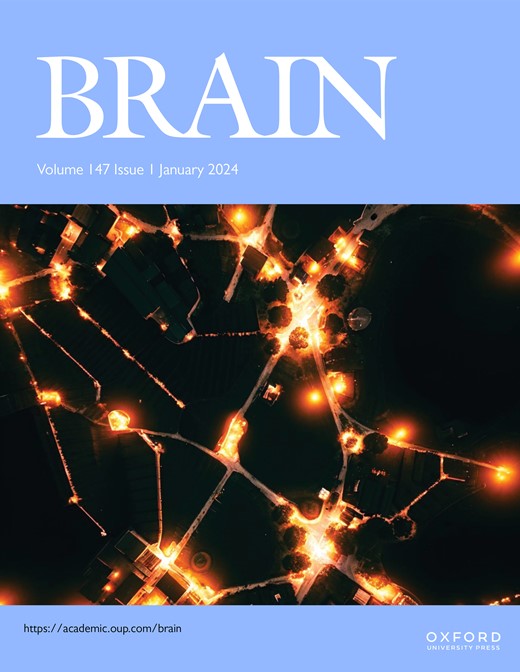Enhancing cognitive performance prediction by white matter hyperintensity connectivity assessment
IF 10.6
1区 医学
Q1 CLINICAL NEUROLOGY
引用次数: 0
Abstract
White matter hyperintensities of presumed vascular origin (WMH) are associated with cognitive impairment and are a key imaging marker in evaluating brain health. However, WMH volume alone does not fully account for the extent of cognitive deficits and the mechanisms linking WMH to these deficits remain unclear. Lesion network mapping (LNM) enables to infer if brain networks are connected to lesions and could be a promising technique for enhancing our understanding of the role of WMH in cognitive disorders. Our study employed LNM to test the following hypotheses: (1) LNM-informed markers surpass WMH volumes in predicting cognitive performance, and (2) WMH contributing to cognitive impairment map to specific brain networks. We analyzed cross-sectional data of 3,485 patients from 10 memory clinic cohorts within the Meta VCI Map Consortium, using harmonized test results in 4 cognitive domains and WMH segmentations. WMH segmentations were registered to a standard space and mapped onto existing normative structural and functional brain connectome data. We employed LNM to quantify WMH connectivity to 480 atlas-based gray and white matter regions of interest (ROI), resulting in ROI-level structural and functional LNM scores. We compared the capacity of total and regional WMH volumes and LNM scores in predicting cognitive function using ridge regression models in a nested cross-validation. LNM scores predicted performance in three cognitive domains (attention/executive function, information processing speed, and verbal memory) significantly better than WMH volumes. LNM scores did not improve prediction for language functions. ROI-level analysis revealed that higher LNM scores, representing greater connectivity to WMH, in gray and white matter regions of the dorsal and ventral attention networks were associated with lower cognitive performance. Measures of WMH-related brain network connectivity significantly improve the prediction of current cognitive performance in memory clinic patients compared to WMH volume as a traditional imaging marker of cerebrovascular disease. This highlights the crucial role of network integrity, particularly in attention-related brain regions, improving our understanding of vascular contributions to cognitive impairment. Moving forward, refining WMH information with connectivity data could contribute to patient-tailored therapeutic interventions and facilitate the identification of subgroups at risk of cognitive disorders.通过白质超强度连通性评估加强认知能力预测
推测为血管源性的白质高密度(WMH)与认知障碍有关,是评估大脑健康状况的关键成像标志物。然而,仅凭 WMH 的体积并不能完全解释认知障碍的程度,而且 WMH 与这些障碍的关联机制仍不清楚。病变网络映射(LNM)能推断大脑网络是否与病变相连,是一种很有前途的技术,能加深我们对WMH在认知障碍中的作用的理解。我们的研究利用 LNM 测试了以下假设:(1)在预测认知表现方面,LNM 信息标记超过了 WMH 体积;(2)导致认知障碍的 WMH 映射到特定的大脑网络。我们使用 4 个认知领域的统一测试结果和 WMH 分段,分析了 Meta VCI 地图联盟 10 个记忆诊所队列中 3485 名患者的横断面数据。WMH 分段被注册到一个标准空间,并映射到现有的标准结构和功能大脑连接组数据上。我们采用 LNM 量化 WMH 与 480 个基于地图集的灰质和白质感兴趣区域(ROI)的连接性,从而得出 ROI 级别的结构和功能 LNM 分数。我们在嵌套交叉验证中使用脊回归模型比较了总体积和区域 WMH 体积以及 LNM 分数在预测认知功能方面的能力。LNM 评分对三个认知领域(注意力/执行功能、信息处理速度和言语记忆)的预测能力明显优于 WMH 体积。LNM得分并不能改善语言功能的预测。ROI层面的分析表明,在背侧和腹侧注意力网络的灰质和白质区域,LNM得分越高,代表与WMH的连接性越强,则认知能力越差。与作为脑血管疾病传统成像标志物的WMH体积相比,WMH相关脑网络连通性的测量能显著提高对记忆门诊患者当前认知能力的预测。这凸显了网络完整性的关键作用,尤其是在与注意力相关的脑区,从而提高了我们对血管导致认知障碍的认识。展望未来,利用连通性数据完善WMH信息有助于为患者量身定制治疗干预措施,并有助于识别认知障碍的高危亚群。
本文章由计算机程序翻译,如有差异,请以英文原文为准。
求助全文
约1分钟内获得全文
求助全文
来源期刊

Brain
医学-临床神经学
CiteScore
20.30
自引率
4.10%
发文量
458
审稿时长
3-6 weeks
期刊介绍:
Brain, a journal focused on clinical neurology and translational neuroscience, has been publishing landmark papers since 1878. The journal aims to expand its scope by including studies that shed light on disease mechanisms and conducting innovative clinical trials for brain disorders. With a wide range of topics covered, the Editorial Board represents the international readership and diverse coverage of the journal. Accepted articles are promptly posted online, typically within a few weeks of acceptance. As of 2022, Brain holds an impressive impact factor of 14.5, according to the Journal Citation Reports.
 求助内容:
求助内容: 应助结果提醒方式:
应助结果提醒方式:


